#emd e unit
Text

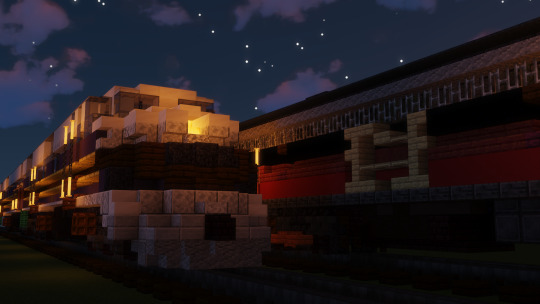
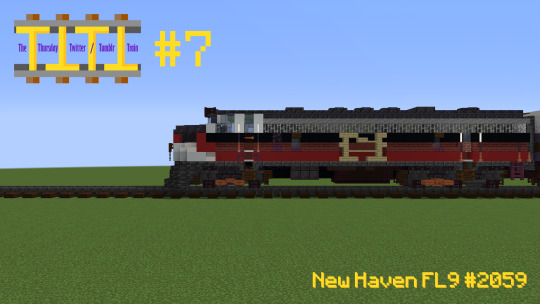


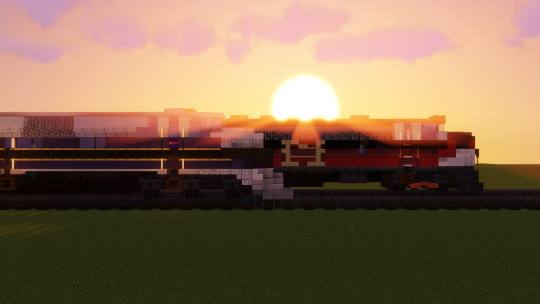
TTTT 7: A pair of legends in the diesel-electric world! B&O's EMD EA/EB #51, the first streamlined diesel engine in history; and NH's FL9 #2059, the last in a line of over 7,600 units in the EMD F family. The latter of these engines never received its own B variant, but in order to let it run through the underground tunnels to NY Grand Central, it was fitted with electrical equipment, third-rail contact shoes, and an extra rear axle to carry them!
6 notes
·
View notes
Text

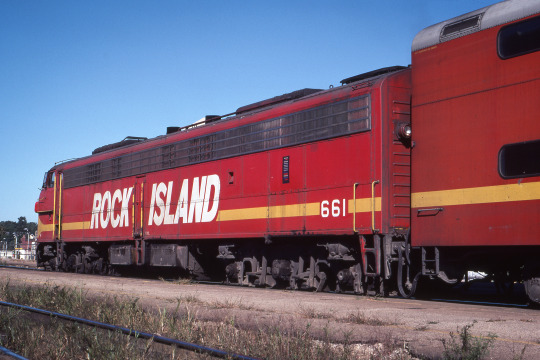
Joliet
This image shows a Rock Island outbound commuter train clacking over the ATSF/GM&O tracks at Joliet. This has always been a great spot for rail enthusiasts.
The wonderful station here is made from Indiana limestone, but I'm not certain about the make up of iconic tower on the other side. The locomotive is an EMD E8A built for the Union Pacific in 1953.
Two images by Richard Koenig; taken in 1976.
#railroadhistory#railwayhistory#filmphotography#jolietillinois#jolietil#joliet#atsf#gm&o#cri&p#commutertrain#chicago#chicagotrains#chicagorailroads#e-unit#emde-unit
30 notes
·
View notes
Text
Trains in The Pacific (2010)
Number one: Victorian Railways K Class as itself (1) (3)




Number two: Victorian Railways S Class as Santa Fe Railway EMD E-Unit (1) (3)



Number three: Victorian Railways S Class as Louisville & Nashville Railroad EMD FT (1) (3)


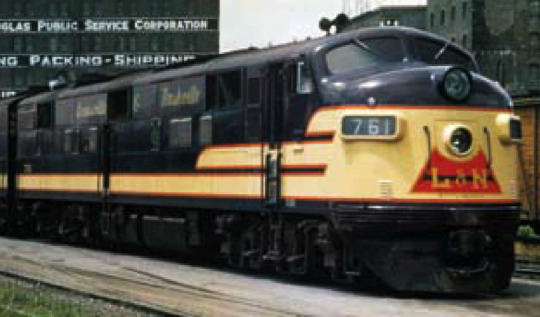
Number four: Victorian Railways Club Car Moorabool as Louisville & Nashville Railroad dining carriage (1)
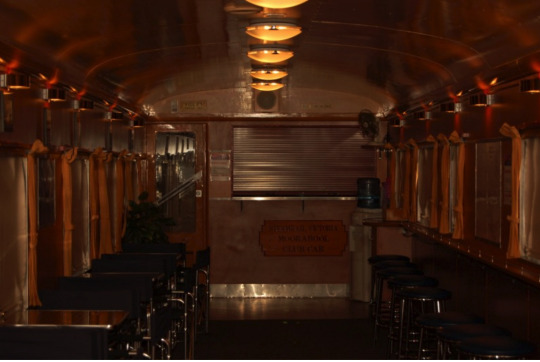

Number five: Victorian Railways Club Car Moorabool as Louisville & Nashville Railroad sitting carriage (1)

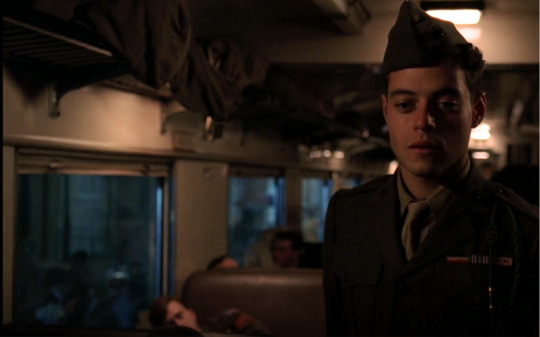
Number six: Victorian Railways Club Car Moorabool as Santa Fe Railway club car (1)


Number seven: Victorian Railways G Type Carriage as Victorian Railways BPL Type Carriage (1)

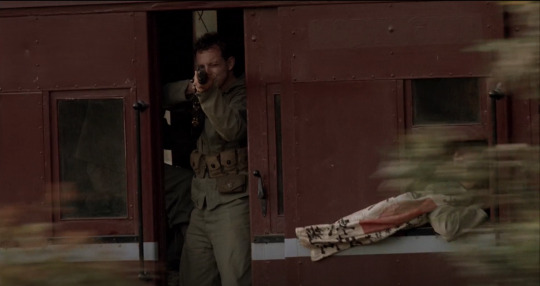
Number eight: Victorian Railways BPL Type Carriage as itself (1)


#hbowar#the pacific#the pacific (2010)#trains#victorian railways#xoxo.monty#monty does trains#thecific#all the screenshots are mine btw#i am now working on a more detailed post sooo stay tuned#also if you have questions i love to answer questions please ask questions#i think i'm going to schedule this for 10pm so more people see it
58 notes
·
View notes
Photo

C&S E5 9955
Colorado & Southern Railway E5 9955 at Larkspur, Colorado on an unknown day in October 1967, Kodachrome by H. C. Crist, Chuck Zeiler collection. Built as CB&Q 9914A (named Silver Arrow) in June 1941 (c/n 1301) on EMD Order E377, it was sold to the C&S September 20, 1961, becoming C&S 9955, and was traded in on an order of SD40's on March 15, 1968. It is seen here in freight service after the C&S and FW&D discontinued passenger service in 1967. The following is from the Burlington Route Historical Society's Burlington Bulletin 10, The E's, edited by Hol Wagner: In their final months of service on the C&S, the last of the E5's were used, rather unsuccessfully, in freight service over the Joint Line between Denver and Pueblo. This line includes a steep grade in both directions to the divide at Palmer Lake, and even though the former Q E5's had been geared down, the graceful units were still high speed passenger power. Running in five and six-unit sets, the now filthy stainless steel speedsters were forced to double the hill up to Palmer Lake with 30-35 cars at a time. And still they fell well below their continuous rated speed of 29 mph, so traction motors, and even main generators, were burned up at a frightening pace. This indignity lasted only a couple of months (September 21 to November 10, 1967), because it served to render nearly all of the units inoperable.
48 notes
·
View notes
Video
Covered Wagons Along the Hudson por Don Kalkman
Por Flickr:
A pair of Metro-North EMD FL9s shove train 8812 past Breakneck Ridge along the Hudson River in 1994. The former New York Central Water Level Route was a fun place back in the day. I can only imagine NYC E-units or a 4-6-4 Hudson on the 20th Century Limited blasting through here.
3 notes
·
View notes
Photo

This SDP was not your father's E unit. EMD was making a clean break from the original art deco inspired cab unit shape. This was to be the new cab unit shape that would last 25 years in the SDP40F- F40 models. This train is the southbound Merchants.
Attleboro, MA
August, 1975
#merchants limited#amtk#amtrak#1975#washington dc#boston#trains#passenger train#history#attleboro#massachusetts
6 notes
·
View notes
Photo

Day 23: EMD SDP40F
Info from Wikipedia:
The EMD SDP40F was a six-axle 3,000 hp (2.2 MW) C-C diesel–electric locomotive built by General Motors Electro-Motive Division (EMD) from 1973–1974. EMD built 150 for Amtrak, the operator of most intercity passenger trains in the United States. Amtrak, a private company but funded by the United States government, had begun operation in 1971 with a fleet of aging diesel locomotives inherited from various private railroads. The SDP40F was the first diesel locomotive built new for Amtrak and for a brief time they formed the backbone of the company's long-distance fleet.
A series of derailments in the mid-1970s shattered Amtrak's confidence in the locomotive, and many railroads banned it from their tracks. Multiple investigations pointed to issues with the locomotive's trucks, the weight of the water and steam generators used for train heating, or the harmonic vibration of baggage cars behind the locomotive. In 1977 Amtrak decided to move on from the SDP40F in favor of the EMD F40PH, which was already in use on short-distance routes. Amtrak traded most of its fleet into EMD; the components were incorporated into new F40PHs. The remainder were traded to the Atchison, Topeka and Santa Fe Railway (ATSF) for use in freight service. The Santa Fe rebuilt the locomotives and designated them SDF40-2. The Burlington Northern Santa Fe Railway (BNSF), successor to the Santa Fe, retired them in 2002. One of them is preserved.
Amtrak assumed operation of most intercity rail passenger service in the United States on May 1, 1971. Until then such services were operated by various private railroads. The private railroads chose to retain their second generation passenger locomotives for freight service, or to operate the various commuter services which, by law, did not pass to Amtrak. To operate these intercity services the Amtrak had to buy or lease from the private railroads whatever locomotives remained. This left Amtrak with an aging and mechanically-incompatible fleet of diesel locomotives. The mainstays of Amtrak's road diesel fleet were veteran E units and F units, which were 10–20 years old and due for replacement.
The SDP40F was a full-width cowl unit. It was based on the EMD FP45 passenger locomotive and EMD SD40-2 freight locomotive. All three shared the EMD 645E3 diesel prime mover, which developed 3,000 hp (2.2 MW). The locomotive had a gear ratio of 57:20. Maximum speed at full horsepower was 94 mph (151.3 km/h); the locomotive exceeded 100 miles per hour (160.9 km/h) in tests. There were doubts at the time about Amtrak's long-term viability, so the locomotives were designed for easy conversion to freight locomotives should Amtrak cease operation.
In the early 1970s Amtrak's passenger car fleet was steam-heated; Amtrak's requirement called for two steam generators. These were located at the rear of the locomotive. Forward of the generators was a 1,350-US-gallon (5,110.3 l; 1,124.1 imp gal) water tank. This tank rested above the floorline. The lateral motion of the water within was later implicated in several derailments. The primary underbody tank was split between water and diesel fuel, carrying 2,150 US gallons (8,138.6 l; 1,790.2 imp gal) of water and 2,500 US gallons (9,463.5 l; 2,081.7 imp gal) of diesel. Provision was made for eventual conversion to head-end power (HEP), but it was never carried out.
EMD based the SDP40F name on the existing SDP40. Several years earlier, EMD had made similar versions of the SDP45 and SD45 in a full-width cowl unit, which it named FP45 and F45. Although the SDP40F was externally nearly identical to the FP45, EMD chose not to give the new locomotive a similar name such as FP40. EMD wanted to avoid adding a new locomotive type to their catalog due to price controls in effect in the early 1970s. The following year, the F40C name was used for a similar locomotive ordered by the Chicago, Milwaukee, St. Paul and Pacific Railroad (the "Milwaukee Road"), equipped with HEP instead of steam generators.
There were several minor differences between the first 40 locomotives built and later examples. The most important was the installation of lower-profile cooling fans and air horns to avoid clearance problems in the Eastern US.
Amtrak ordered 150 SDP40Fs, in two batches. The first order, placed on November 2, 1972, was for 40 locomotives, at a cost of $18 million. A second order, for 110 locomotives at $50 million, followed on October 12, 1973. These orders were Amtrak's first for new-build locomotives.[18] Amtrak deployed the original 40 locomotives on long-distance trains in the Western United States. The locomotives entered revenue service on June 22, 1973, hauling the Super Chief from Chicago to Los Angeles over the Atchison, Topeka and Santa Fe Railway. SDP40Fs were also used on the Burlington Northern Railroad. The arrival of the second order enabled Amtrak to deploy the SDP40Fs throughout the country, displacing the inherited E-units.
In late 1975 J. David Ingles called the SDP40Fs the "stars of Amtrak's long-distance trains," but engine crews reported that the locomotives rode poorly compared to the E-units they had replaced. Even as Amtrak and EMD investigated the ride quality, the SDP40F was involved in a series of derailments that would lead to an end to its career as a passenger locomotive. Between 1974–1976 the Federal Railroad Administration (FRA) identified thirteen incidents for which the locomotive was responsible. None of the incidents were serious, but their frequency was a concern. Most of the derailments occurred on trains with two SDP40Fs on the front and at least one trailing baggage car. While the rear truck of the second locomotive and the front truck of the baggage car were pinpointed as the source of the derailment, the actual cause of the derailments was unclear.
EMD, Amtrak, the Association of American Railroads (AAR), and the FRA tested the locomotive thoroughly, with suspicion falling on the "hollow bolster" truck design. In the end, the investigators theorized that the steam generators and water tank may have made the rear of the engine too heavy and created too much lateral motion. Later FRA investigations concluded that the actual culprit was the light weight of the baggage cars, which caused harmonic vibrations when placed directly behind the much heavier SDP40F. A contributing factor was the sometimes poor quality of track the locomotive operated over.
Amtrak took several corrective measures, including operating with a reduced speed on curves, emptying the smaller of the two water tanks to reduce lateral motion, and making various alterations to the trucks. The measures helped, but the trouble continued. Several railroads, including the Burlington and the Chesapeake and Ohio Railway (C&O), banned the "rail breakers" from their tracks (they were suspected or known to be causing the spreading of rails because of their lateral swaying, which may have contributed to the derailments)[citation needed]. For the Chicago–Seattle Empire Builder, the speed restrictions added 6 hours to what had been a 46-hour schedule. Another important development was the unusually harsh winter of 1976–1977, which sidelined many of Amtrak's aging steam-heated coaches. Amtrak suspended numerous routes and pressed the new HEP-equipped Amfleet I coaches, designed for short runs, into service. The new EMD F40PH, intended for short-distance service and equipped with HEP, handled these trains.
In the spring of 1977 Amtrak faced a power crisis. In addition to the SDP40Fs derailing, Amtrak was having trouble with two other six-axle designs. The GE E60CP and E60CH electric locomotives were having derailment problems. The GE P30CH had the same truck design as E60s and rode poorly, although it did not exhibit the same tendency to derail. Amtrak decided to abandon the SDP40F in favor of the F40PH, a four-axle design with none of the riding problems of the six-axle locomotives. Amtrak traded 40 SDP40Fs back to EMD. Components including the prime mover were installed into an F40PH's frame. Between 1977–1987 Amtrak traded 132 of the SDP40Fs back to EMD for F40PHRs. The SDP40F remained in service on the Santa Fe longer than elsewhere, although the arrival of HEP-equipped Superliner cars on the Western routes displaced them from there as well. The last SDP40Fs left the Amtrak roster in 1987. The remaining Amtrak SDP40F's that weren't sold to the ATSF (seen below) are presumed to have been scrapped.
In 1984 Amtrak, low on light-duty power, traded 18 SDP40Fs to the Santa Fe for 43 switchers: 25 CF7s and 18 SSB1200s. Santa Fe rebuilt the traded locomotives for freight use. Modifications included removing the steam generators and regearing for lower speed. The locomotives were also given front steps and platforms, and notched noses in order to improve boarding access. The rebuilt locomotives were designated SDF40-2. The SDF40-2s continued in service with the BNSF Railway, successor to the Santa Fe, until their retirement in 2002.
One SDF40-2, ex-Amtrak No. 644, was acquired by Dynamic Rail Preservation Inc. and is in Boulder City, Nevada having been previously displayed in Ogden, Utah. It has been renumbered to its Santa Fe-era 6976 number and returned to operation in November 2019.
models and route by: American Trainz Group, trainzman54, Auran, and Download Station
#EMD#EMD SDP40F#Amtrak SDP40F#SDP40F#Amtrak#Diesel Locomotive#Trainz Simulator#Trains#Advent Calendar#Christmas#Christmas 2022 🎄🎅🎁
2 notes
·
View notes
Text
Events 5.15 (after 1930)
1932 – In an attempted coup d'état, the Prime Minister of Japan Inukai Tsuyoshi is assassinated.
1933 – All military aviation organizations within or under the control of the RLM of Germany were officially merged in a covert manner to form its Wehrmacht military's air arm, the Luftwaffe.
1934 – A self coup by prime minister Kārlis Ulmanis succeeded in Latvia, suspending its constitution and dissolving its Saeima.
1940 – USS Sailfish is recommissioned. It was originally the USS Squalus.
1940 – World War II: The Battle of the Netherlands: After fierce fighting, the poorly trained and equipped Dutch troops surrender to Germany, marking the beginning of five years of occupation.
1940 – Richard and Maurice McDonald open the first McDonald's restaurant.
1941 – First flight of the Gloster E.28/39 the first British and Allied jet aircraft.
1942 – World War II: In the United States, a bill creating the Women's Army Auxiliary Corps (WAAC) is signed into law.
1943 – Joseph Stalin dissolves the Comintern (or Third International).
1945 – World War II: The Battle of Poljana, the final skirmish in Europe is fought near Prevalje, Slovenia.
1948 – Following the expiration of The British Mandate for Palestine, the Kingdom of Egypt, Transjordan, Lebanon, Syria, Iraq and Saudi Arabia invade Israel thus starting the 1948 Arab–Israeli War.
1957 – At Malden Island in the Pacific Ocean, Britain tests its first hydrogen bomb in Operation Grapple.
1963 – Project Mercury: The launch of the final Mercury mission, Mercury-Atlas 9 with astronaut Gordon Cooper on board. He becomes the first American to spend more than a day in space, and the last American to go into space alone.
1970 – President Richard Nixon appoints Anna Mae Hays and Elizabeth P. Hoisington the first female United States Army generals.
1972 – The Ryukyu Islands, under U.S. military governance since its conquest in 1945, reverts to Japanese control.
1974 – Ma'alot massacre: Members of the Democratic Front for the Liberation of Palestine attack and take hostages at an Israeli school; a total of 31 people are killed, including 22 schoolchildren.
1988 – Soviet–Afghan War: After more than eight years of fighting, the Soviet Army begins to withdraw 115,000 troops from Afghanistan.
1991 – Édith Cresson becomes France's first female Prime Minister.
1997 – The United States government acknowledges the existence of the "Secret War" in Laos and dedicates the Laos Memorial in honor of Hmong and other "Secret War" veterans.
1997 – The Space Shuttle Atlantis launches on STS-84 to dock with the Russian space station Mir.
2001 – A CSX EMD SD40-2 rolls out of a train yard in Walbridge, Ohio, with 47 freight cars, including some tank cars with flammable chemical, after its engineer fails to reboard it after setting a yard switch. It travels south driverless for 66 miles (106 km) until it was brought to a halt near Kenton. The incident became the inspiration for the 2010 film Unstoppable.
2004 – Arsenal F.C. go an entire league campaign unbeaten in the English Premier League, joining Preston North End F.C. with the right to claim the title "The Invincibles".
2008 – California becomes the second U.S. state after Massachusetts in 2004 to legalize same-sex marriage after the state's own Supreme Court rules a previous ban unconstitutional.
2010 – Jessica Watson becomes the youngest person to sail, non-stop and unassisted around the world solo.
2013 – An upsurge in violence in Iraq leaves more than 389 people dead over three days.
0 notes
Text

Indian Railway Minister Ashwini Vaishnaw in his speech in Rail Bhavan, announced eAuction of NFR assets digitally.
June 24, 2022 - Rail Bhavan, Delhi
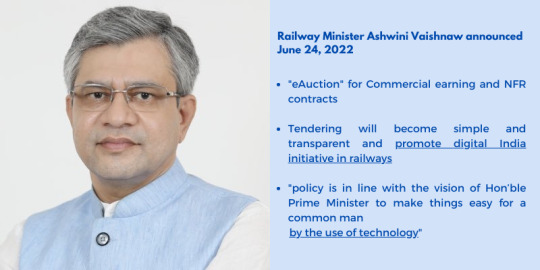
Indian Railway's current NFR income is 8% of it's overall income, and it seems very difficult to make it reach 20% which is the Global Standard.
For the first time, Indian Railway has brought the commercial earnings and Non-Fare Revenue (NFR) by the use of electronic auction through, Indian Railway e-Procurement System (IREPS) with effect from June 24.
NFR (Non-fare revenue)
is the income from various sources, excluding passenger and freight receipts.
These sources include: Parcel Van, Pay & Use Toilets, Advertisement rights on station circulating area and coaches, AC waiting rooms, Cloak rooms, Parking lots, Plastic Bottle crushers, ATMs, Station co-branding, Video screens for content on demand etc.
This move will especially give a boost to small entrepreneurs and start-ups. No financial turnover requirement will be for annual contracts of up to 40 lakh.
It will end the tedious process of tendering. which requires physical registration with the concerned field unit. This makes difficult for potential bidders from the rest of India to compete. It takes time in finalization due to requirement of physical meeting of tender committee members
The auctioning of tendering railway services like like parcel van, advertisement rights on station circulating areas and coaches, the AC retiring room, cloakrooms, parking slots, etc. will become a lot smoother
eAuction Process:
Bidder located anywhere in India need to self register once for participating in auctions of any field unit of Indian Railways through the portal
Remotely bid can be placed for management rights of an asset after depositing earnest money (EMD) electronically
Successful bidder would be able to receive acceptance online and through e-mail in very short span of time
There is no financial turnover requirement for annual contracts upto Rs. 40 lacs
Dont't miss this golden Chance!! More than 10,000+ hashtag#railwaytenders availlable This year. click the link below👇🏼 https://lnkd.in/dvN5rXzn Sign up today on www.tendertiger.com and win the best tenders for your business stay updated about for upcoming tenders and get complete bid assistance to make sure you win the right tenders for your business.
Failed at First Attempt: The decision to generate income from NFR sources was made in 2010-11, On 24 February 2010 the then Railway Minister Mamata Banerjee in her budget Speech promised to utilize untapped resources And increase revenue from ₹ 150 crore to ₹ 1,000 crore
However, nine years later it made just ₹ 32.65 crore in April 2018. According to Minister of state for railways Rajesh Gohain, The earnings were primarily from commercial publicity at stations, coaches, wagons, loco, railway land, foot overbridge, road over bridge, road under bridge, etc.
Present Success Stories during Pilot Run: Parking site – Anand Vihar Terminal, Contract Period – 3 year, Total Bids Received – 74,Offer Price per annum- 75 lakh. Total earning – Total 2.25 Cr. Offer received was 127.33% higher than the conventional bidding price
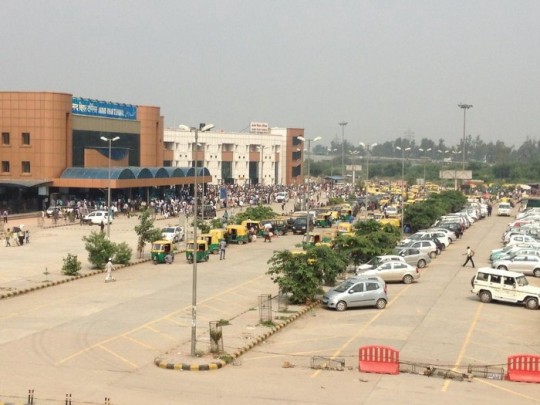
0 notes
Video
Class on the Trunk by Greg Brown
Via Flickr:
The Union Pacific E units roll an excursion train down Trout Creek Canyon in 1995, nearing the Deschutes River. While there have been many excursion trains on the Oregon Trunk over the years, for my money this elegant streamlined reminder of the City of Portland was the belle of the ball.
#Trout Creek#Oregon#Union Pacific#UP#EMD#E unit#Oregon Trunk#BNSF Oregon Trunk Subdivision#streamliner#Passenger Train#Trains#Railroads#Deschutes River Canyon
29 notes
·
View notes
Video
Covered wagons at rest by Mike Danneman
Via Flickr:
A group of Burlington Northern E9s lay over in the commuter yard at Aurora, Illinois, on June 8, 1991.
Photo by Mike Danneman
#Burlington Northern#BN#E9#E unit#9920#commuter trains#commuter#Aurora#Illinois#locomotive#EMD#covered wagon#cab unit#IL#passenger train#train#trains#track#tracks#Metra#EMD E9#diesel locomotive#trainspotting#rr#rail#rails#railroad#railroads#railway#railways
61 notes
·
View notes
Photo



Amtrak’s Inter-American
Not great photographs here, but the content makes it worthwhile to inspect and interpret what was versus what remains.
This is a southbound number 21, the Inter-American, crossing College Avenue in Normal, Illinois. This is the former Chicago & Alton, later Gulf, Mobile & Ohio. One may note the distinctive B&O signals here—a result of the C&A being controlled by that major railroad. It was Illinois Central Gulf at the time of these pictures, and is now of the Union Pacific (with another group owning the line in between these last two).
The train is approaching a spot in Normal that will host a passenger station (MP 124), but at this time trains stopped a bit further down the line in Bloomington itself. One will also note the the train will meet a northbound freight with an ICG unit on point. Illinois Central’s charter line cuts across the Alton near where that train can be seen. Looking at Google Maps today, it’s clear that this historical line of the IC no longer exists here (though it does in bits and pieces in other parts of the state). And looking at Google Street View, it’s difficult to recognize anything from these vintage views—other than the high-rise buildings, which I assume are connected to Illinois State University.
The train is being powered by three E-units—two are former Union Pacific E9s (built in 1955) while the middle unit is an E8 (built in 1953) of the RF&P. Two are in Phase II paint (so-called cigar-band), while one is in the original Phase I (bloody-nose) scheme. I didn’t realize this train, the Inter-American, went all the way to Laredo, Texas, and had connecting service with National Railways of Mexico. I’ll add a timetable page above (copyright Amtrak, by way of timetables.org).
Two images by Richard Koenig; taken November 21st 1976.
#railroadhistory#railwayhistory#amtrak#inter-american#e9a#e8a#emd#e-unit#bloomington-normal#illinoisstate
46 notes
·
View notes
Text
ACL #500 and #501

Imaged above is the ACL #501 in the NC Transportation Museum
The Atlantic Coast Line ordered two EMC E3 models (numbered 500 and 501) from Electro-Motive Division of General Motors. They were to be used for service on The Champion, a streamlined train operated between the Atlantic Coast Line and the Florida East Coast Railway, between Miami, Florida and New York, New York. These locomotives were produced with 2,000 horsepower. Both were finished in 1939, however 501 was wrecked and rebuilt into a EMD E6 model before it was delivered. The ACL chose a purple and silver for their liveries, partially due to the use of it on the company turntables.
The Atlantic Coast Line No. 501 is a preserved Diesel-Electric EMC E3/EMD E6. It is notable as being the sole survivor of the EMC E3 Class even though it was rebuilt before it was delivered. It currently resides at the North Carolina Transportation Museum in Spencer.
The No. 501 remained pulling The Champion until 1970, with over 6 million operating miles (making it the most traveled E unit in United States History). In the 1980s, it operated on the Wisconsin Western Railroad (a short-lived heritage railway). In 1998, the North Carolina Department of Transportation Rail Division purchased the 501 and placed it on long term loan to the NC Transportation Museum.
The No. 500 was not as lucky, being involved in the worst railroad accident in North Carolina history. The Rennert Railroad Accident (also referred to as the Tamiami Champion Accident), happened on December 16, 1943 in Rennert, NC. It was the very early hours of the morning when the Nos. 514, 753, and 514 were running late southbound when 3 of its 18 cars detached and derailed blocking both lines. The crew attempted to set flares, which were damaged after one crewman slipped on the ice. After failing to catch the attention of the northbound train with a waving lantern (pulled by the Nos. 506, 503, and 500), the train crashed and derailed around 1:30 in the morning. Because of the severity of the accident, location away from the main road, the terribly cold weather, and the limited supplies around 72-74 people were killed, and another 187 injured. Even today, it is considered the worst railroad accident in North Carolina.
After this accident and another in Georgia in 1953, the No. 501 was rebuilt into a EMD E8a unit. And though assumedly scrapped, not much is known about the history of this locomotive after this time.
(a valentines gift for my honeybun :3)
#trains#irl trains#locomotives#acl 500#acl 501#atlantic coast line#the champion train#rennert railroad accident#locomotive history#irl locomotive history#diesel electric locomotive
11 notes
·
View notes
Video
RI 662 GE 4717 #04 EB Bureau 11-25-78 by Lloyd Rinehart
Via Flickr:
East bound freight, 04, has an E unit leading a GE U-B and a EMD GP40 at Bureau, Il.
11 notes
·
View notes
Video
DGVR 7094 Elk River Junction WV por Ian M. Hapsias
Por Flickr:
Durbin and Greenbrier Railroad's New Tygart Flyer is crossing over the Shavers Fork of the Cheat River at Elk River Junction, WV. This popular West Virginia tourist train departs from downtown Elkins, WV to the 18' high, 150 foot wide High Falls of Cheat deep within the Monongahela National Forest. The leisurely paced train ride is a 4 hour 45 minute round trip on the former Western Maryland GC&E Sub. The lead unit is a former Milwaukee Road EMD F7A masquerading as a C&O painted engine. The fall colors weren't quite yet at peak during this early October day, but mild temps and blue skies made for a tremendously enjoyable day deep within the remoteness of West Virginia. Visible high on top of the ridge in the background is the once famous Raven Rock that looked down on this unique Western Maryland junction, but has sadly succumbed to being overgrown by vegetation.
4 notes
·
View notes
Photo
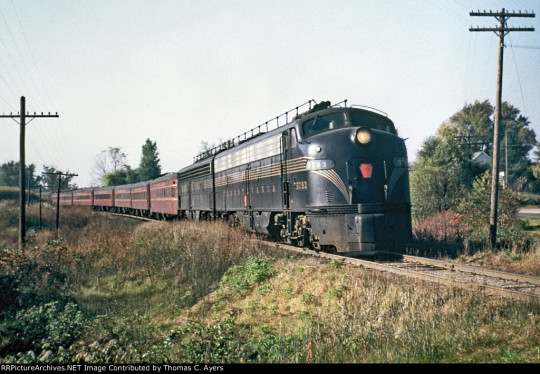
Shown here (R to L) are Pennsylvania Railroad engine #5793 and another E-8A unit whose number is not recorded. Both were built by GM-EMD and rated at 2,250 horsepower each. #5793 was built in June of 1952. In this context, they are pulling a "Football Special." Note that the first car in the train is actually an observation car!
Lakeville, Indiana
11 October 1952
#football special#prr#pennsylvania railroad#1952#trains#passenger train#history#lakeville#indiana#observation car
19 notes
·
View notes

